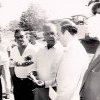1960s
1960
The industrialisation of the Georges River has direct effects for Aboriginal people. Land is needed rapidly to build cheap hostels for factory workers. One area where some Koori people come to live is Herne Bay . Virtually all the urban migrant hostels in Sydney are on the Georges River in places like Chullora, Bankstown Aerodrome, Villawood, East Hills and Heathcote Rd. Goodall and Cadzow, Rivers and Resilience, p 187-9
Sally and Sam Smith move from Wellington with their daughters Janny and Judy. The family moves first to Redfern, then to Herne Bay (now Riverwood), upstream from the old Salt Pan Creek community sites, to some old Army buildings.
1963
The Smith family move from Herne Bay to Green Valley, further west. They experience racism directed against them, including a petition claiming that their presence will cause housing prices to drop. Their father says, "You OWN this country!. Don’t worry about them other fellas out there!". Goodall and Cadzow Rivers and Resilience, p 201
Another family to move from Herne Bay to Green Valley is Charlie Leon’s.
1964
Randwick Council recommends that the Aboriginal population at La Perouse be “integrated into the adjacent housing commission development”, because the housing on the reserve is of a poor standard. Charles Leon reports that the La Perouse Aborigines are strongly opposed to Randwick council’s proposed plan and demand that it develop, instead, La Perouse as a modern housing estate for Aborigines.
Meanwhile, the AWB (Aborigines Welfare Board, successor to the Aborigines Protection Board))has begun to demolish some of the older huts on the La Perouse reserve as they become vacant and to threaten families with eviction for non-payment of rent. The Kooris fear the Board’s intention is to drive them off their land in order to help Randwick council open up the reserve for white residential development. Goodall, p 323.
1965
1967
The National Parks Act allows for the establishment of parks, but without sufficient interest in urban Aboriginal culture. Dean Kelly, a La Perouse environmental spokesman, speaks of the period: They have had no boomerangs since that time(1967), because now that [mangrove] plant is protected. And if you harvest that plant, regardless of what is it was for - medicine, artefacts or food – you would be charged and fined or jailed. So it's caused a whole lot of problems for our people. We are just trying to sort that out now [2007], with access to country and use of natural resources. Goodall and Cadzow Rivers and Resilience, p 276
See Dean Kelly on Kamay Botany Bay vimeo.com/14915480












.thumbnail.JPG)
